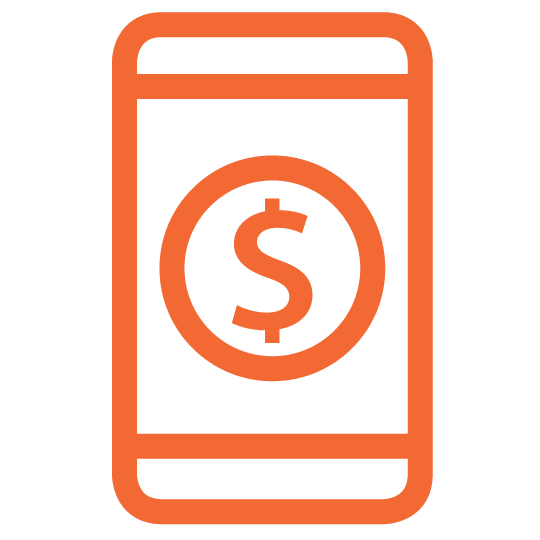TRACK YOUR JOINT EXPENSES
It’s hard enough keeping track of your own expenses. So you shouldn’t be surprised that managing money as a team effort can test your patience, especially if your partner has a different method of keeping financial records—or worse, no method at all.
In some ways, it’s easier for you today than it was for your parents or grandparents, who could keep track of how much they had in their checking accounts only by balancing their checkbook. This meant writing down every deposit and withdrawal to add or subtract from their total. Thank goodness modern banking has evolved to make it much easier.
These days finding out your balance is as easy as checking your account on a mobile app, on your computer, or at the ATM.
But tracking expenses isn’t about realizing that your balance is $300 less today than it was yesterday. It’s knowing where the $300 went and whether that spending is in line with your plan.
Tracking Tools
If you find keeping accurate track of what you spend challenging, a digital spending tracker might be helpful. Most basic functions on apps or websites are free, but some have add-on features designed to provide more options or insights that you’ll need to pay for.
It’s worth it to take the time to compare some of the available options. Choosing one that you’re comfortable with, and that presents information in a way that makes sense to you, will make a big difference in how useful you find it.
Once you’ve signed up, spend some time figuring out which type of information will help you best. For example, you can usually select whether your spending is organized by category or by cash flow.
Category:
- Amounts you spend are allocated to different types of expenses, such as groceries or phone bill.
- You get alerts when you’re approaching the limit you’ve designated for that category.
Sound like the way to go? Check out Mvelopes.
Cash Flow:
- When cash is added to your account, the app automatically deducts your regular debits, such as what you’ll pay for housing or utilities when those amounts are due.
- When you make purchases, those amounts are also subtracted. This keeps you aware of how much cash you really have available to use, not just what’s in your account.
Is this more your style? Look at Wally.
Apps to Check Out
For some people, seeing how much they’re spending on clothing and shoes on a monthly basis is enough to help them slow down the shopping. For others, seeing the dollar amount available for discretionary spending is all they need to curb their spending impulses. And for some couples, the information is enough to make them realize they need to reduce large set costs, which might mean moving to a smaller apartment or leasing a less expensive car.
Although it may be a difficult conversation, comparing your spending with your partner’s may be a huge step forward in getting on the same financial page. This is especially true if you’re sharing household expenses, with each partner responsible for specific categories.
Probably the most controversial feature of these apps is that most, though not all, require access to your bank, credit, and investment accounts so they can pull the information they need to track your spending. In some cases you can enter the information yourself, which makes sense especially if you make a lot of purchases in cash, instead of with credit or debit, which is entered automatically.
The Buck Stops with One of You
Setting financial goals, developing a money management strategy, and following through on your spending decisions require a joint effort. But that doesn’t have to be true about tracking your expenses. When you’re dividing up your household chores, you might agree that one of you should take primary responsibility for monitoring spending in your joint account, paying the bills that are due, and confirming the balance is always positive.
Fixing Problems
If it turns out that one of you, or both of you, are not following the spending plan you agreed on, what’s next? Chances are it means you’re spending more than you had intended to on certain types of expenses or were unrealistic about what specific things would cost.
The best first step is to rethink the amounts you’ve allocated to various categories. For example, if transportation costs are higher than you planned, and there’s no feasible way to reduce them, can you agree to cut back on what you’re spending on something else? Fixed expenses are the most difficult to adjust. For example, probably the only way to reduce your rent is to move, and that involves costs of its own. But other costs that are variable, like food and entertainment, are fair game.
The worst-case scenario is that one of you is overspending and unwilling or unable to change. It’s a problem you’ll have to face as a couple if there’s any hope of your having a healthy financial relationship and future.
Partner Passwords
You’ve been warned repeatedly never to share your account passwords, but that rule doesn’t apply with your partner.
Each of you must have access to your joint online bank and investment accounts, digital spending trackers, and any other financial apps you and your partner use in managing your money. That doesn’t mean you’re giving up your privacy. But it is one place where there can’t be any secrets.
If you’re looking for an electronic password keeper, Ascendo’s DataVault Password Manager is a good choice because it allows you to keep passwords and other important data securely on a computer or mobile device without having the information uploaded to the cloud.
Try This:
Keep a notebook (a real paper one, not a digital one) that contains all the passwords that you’ll both need for financial accounts. Store it in a place where you can both access it easily, but that’s not just lying around for anyone to find. This might also be a good place to keep information like the location of any bank safety deposit boxes that either of you has rented and online passwords to household accounts like utilities and cable.














